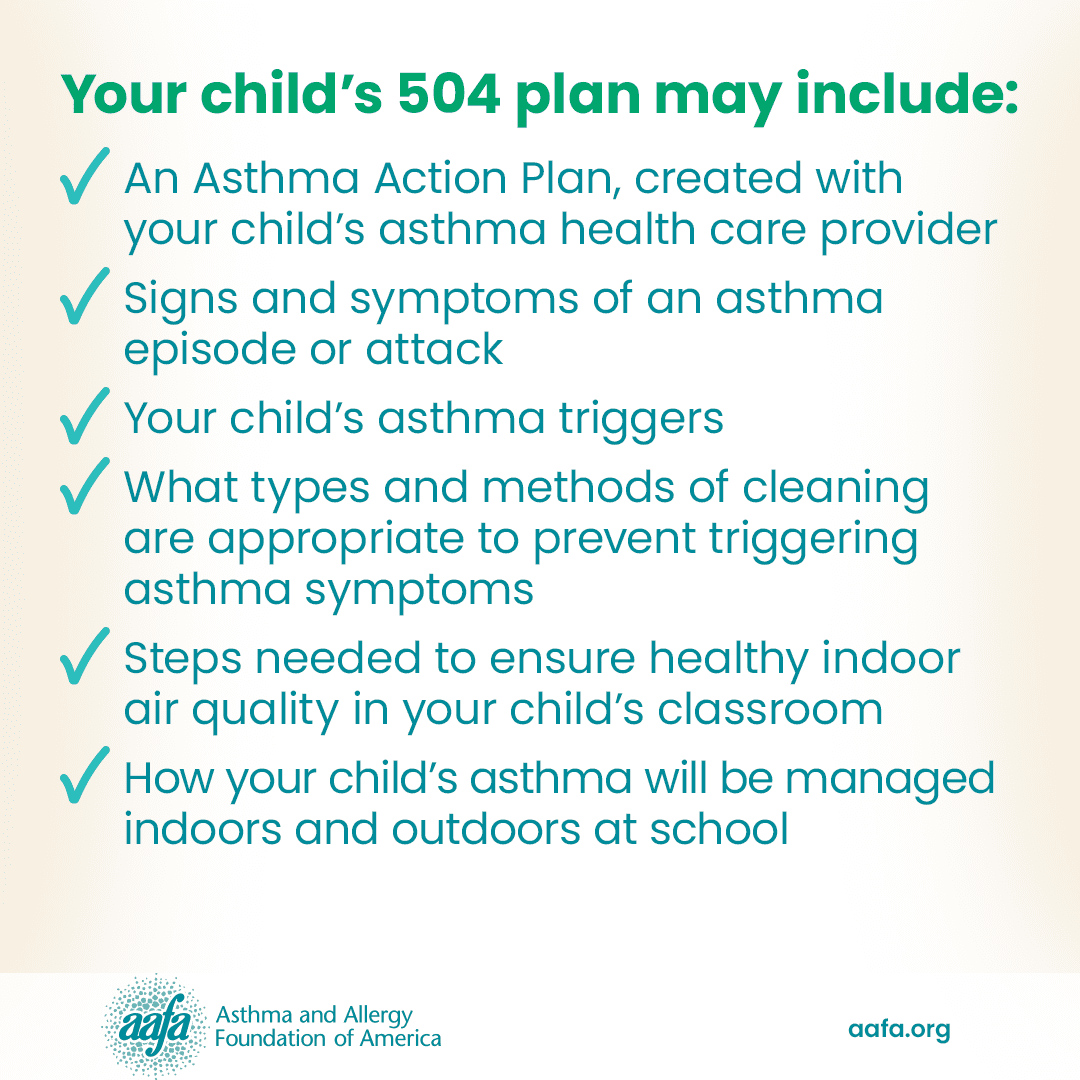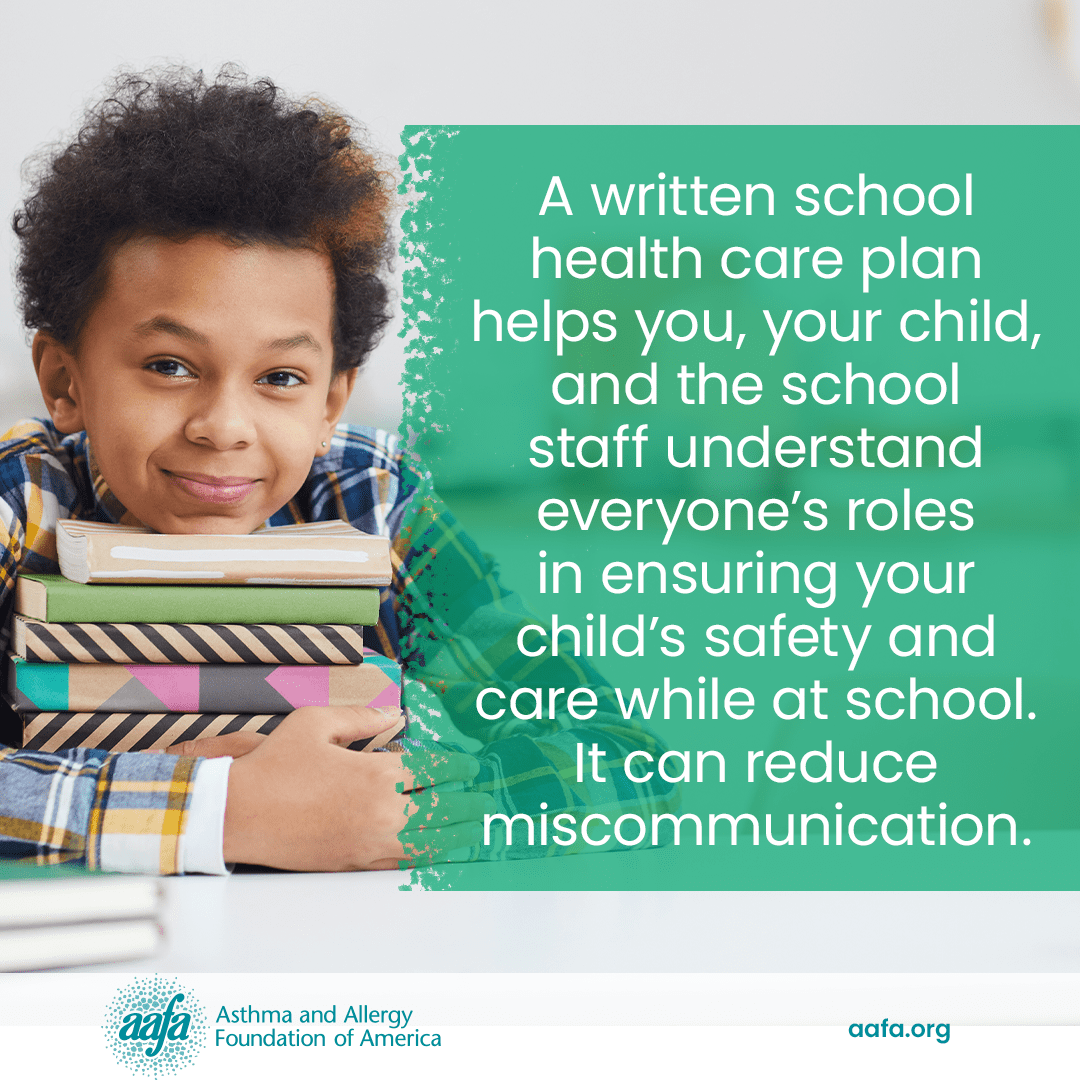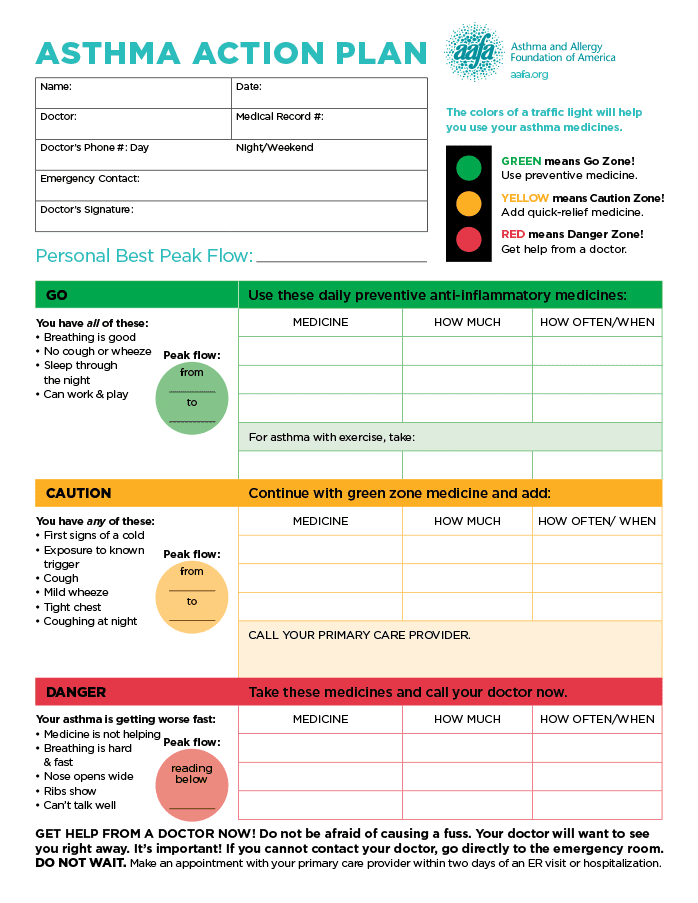Asthma
504 Plans for Asthma
If you are a parent of a child with asthma, you know how much work managing it can be. You have to make sure they take their medicines like they are supposed to, watch for signs and symptoms, and help them avoid their triggers.
But what happens when they are at school? How can you feel confident the school staff will manage your child’s asthma properly and know how to handle asthma episodes or attacks?
A 504 plan may be an option. It is a tool that can help you work with your child’s school so you can all be on the same page when it comes to keeping your child healthy.

What Is a 504 Plan?
Simply put, a 504 plan is a contract between you and your child’s school. It addresses how the school will accommodate your child’s asthma.
Its name comes from Section 504 of the Rehabilitation Act of 1973. It’s a law that says schools that get federal funding cannot exclude or discriminate against students who have disabilities.1
A disability under Section 504 is defined by the Americans with Disabilities Amendments Act (ADA) as a “physical or mental impairment which substantially limits one or more major life activities.” A “major life activity” includes walking, seeing, hearing, speaking, breathing, learning, working as well as eating.2 Under Section 504 and the ADA, asthma is often considered a disability, depending on severity. A school needs to evaluate the effects of a child’s asthma without considering the benefits of using medicine to deal with symptoms.3

Does My Child’s School Have to Follow a 504 Plan?
It depends. If a school receives federal funds, they have to follow Section 504. This includes public schools, including preschools, as well as private schools that receive some form of federal funds.4 Colleges do not have to follow 504 plans but have obligations under section 504.
Does My Child with Asthma Need a 504 Plan?
Not every child with asthma needs a 504 plan.5 When trying to decide, ask yourself these questions:
- Does the school already have effective asthma management policies and procedures in place?
- Does the school have a full-time nurse on site?
- Do they train their staff about asthma management?
- Will my child have easy and quick access to their asthma medicines?
- How likely will my child miss a lot of school days due to their asthma?
- How often is my child having asthma symptoms?
- Does the school environment cause asthma symptoms?
- Will my child need accommodations when participating in physical education classes or sports?
- How well is the school responding and cooperating with requests?
Your child’s school may already have an effective plan in place for asthma management. After all, asthma is one of the most common chronic diseases in U.S. children. An individual health care plan (IHCP) may be all that is needed for your child.
But if your child has additional needs that you are concerned about, you may want to consider a 504 plan.
There are three common types of care plans used in many schools:
- Emergency care plan (ECP) – This is a medical plan from your child’s doctor for the school to follow to treat asthma while the student is at school.
- Individual health care plan (IHCP) – This is a type of nursing care plan. For a student with asthma, this would also include an emergency care plan.6 An IHCP addresses what the school will do to establish and maintain a safe school environment for the student with asthma.
- 504 plan – This is a legally-binding plan written by the school in collaboration with a student and their family.4 Similar to an IHCP, this plan provides guidelines for changes in the classroom or other school locations to achieve the goal of providing a safe education.
Keep in mind that having asthma does not automatically mean your child qualifies for a 504 plan. Before a 504 plan can be put into place, the school needs to evaluate your child.5 Your child must meet the official definition of having a disability.
You can help your school with this process by having documents from your child’s doctor showing that your child’s asthma seriously limits “major life activity.” Breathing is a “major life activity.”2
How Do I Start the 504 Plan Process?
Start by contacting the school’s principal and the school district’s 504 coordinator. Ask to have your child evaluated for a 504 plan. Once they decide your child is eligible, ask for a meeting to start creating a plan.
The goal of the plan is to ensure your child’s health and manage their asthma while at school. This process can take some time, so you’ll want to start well before school starts. Some parents even start the process in the spring semester for the following school year.
Stay positive when working with the school. The hope is for you and the school staff to work as a team to make sure your child is safe. Communicate often, calmly, and confidently.

How Do I Create a 504 Plan?
Work with the school to create the plan. Look up some sample 504 plans to give you an idea of what yours might include. Your school district may also have forms or formats. You can start with these, making changes to fit your child’s needs. There is no official federal 504 plan document.
Think about what accommodations your child needs. Consider their asthma triggers and what they are likely to be exposed to at school.
The Asthma and Allergy Foundation of America (AAFA) has school planning resources that can help guide you. The Centers for Disease Control and Prevention (CDC) has school resources as well. And your state health department may already have some guidelines you can refer to.
Here are some things your child’s 504 plan might include:
- Your child’s Asthma Action Plan (created with your asthma health care provider)
- Signs and symptoms of an asthma episode or attack
- Your child’s asthma triggers
- What types and methods of cleaning are appropriate to prevent triggering asthma symptoms
- Steps needed to ensure healthy indoor air quality in your child’s classroom
- How your child’s asthma will be managed indoors and outdoors at school
- If your child can access and use their own asthma medicine
Your child’s 504 plan should also address:
- Who will be responsible for what?
- What training will be required? Who will deliver this training? Who will be trained? Will a trained person always be present during the school day and on field trips?
- What special services, if any, will the school provide to keep your child’s environment safe? Will they give your child medicine? Will they give them space and time to use their medicines (e.g., inhalers with spacers or a nebulizer)? Can changes be made to the classroom environment?
- How will the school handle missed classes and school work? Will your child be allowed to make up time or school work missed due to asthma?
- What policies need to be in place to help your child avoid their triggers and take their medicine as needed? Will they be given time to use their quick-relief medicine before physical activity?
- If your child has as asthma episode or attack while at school, what is the emergency treatment plan?
It’s best to get the 504 plan in writing. The law does not require it. But it is a best practice. This reduces the chance for mistakes or misunderstandings. A written plan should be available for all staff members who interact with your child. This includes classroom teachers, substitute teachers, other teachers (gym, music, art, etc.), custodians, and lunchroom staff. But the only people who need to sign plan are the 504 coordinator and the parents or guardians.
What If the School Does Not Follow the 504 Plan or Refuses to Accommodate My Child?
All schools that accept federal funding must accommodate your child. Some parents, though, may run into issues, such as:
- The school refuses to create a 504 plan after your child is evaluated and found eligible
- The school creates an unacceptable 504 plan leading to recurrent asthma episodes and/or missed school days
- The school creates an acceptable 504 plan but then doesn’t follow it
If the school says that they “do not do 504 plans for asthma,” remind them of the Section 504 law.
Schools must create due process procedures that includes parental notification, review requirements, and an impartial hearing with a parent/guardian, and even legal counsel present. If the school creates a 504 plan that does not include any of your requests, you do not have to agree to it. If this happens, write a letter to the school consistent with the procedures laid out. Tell them you do not agree and would like another evaluation meeting. Remind them you have the right to be involved in creating your child’s 504 plan.
Your requests need to be reasonable and should focus on the accommodations that are needed to keep your child healthy and safe in school.
Stay calm and polite at the meeting. Explain why the plan that the school wrote will not work. Let them know what parts you disagree with. Tell them why your requested changes are important.
If the school still refuses to cooperate, you can file a complaint with the Department of Education’s Office for Civil Rights (OCR).
You may also be able to file a complaint with your state Board of Education. Your state may even have processes in place.
What Happens If My Child Moves to a New School?
If you have a 504 plan in place when you move, the plan goes with your child.
Before you move, contact the new school. Let them know your child has a 504 plan and send them a copy. If they are OK with the plan, they must put it in place as is.4
Sometimes, a school may say the existing 504 plan will not work for their school. If this happens, they must follow your existing plan until a new plan is in place. You’ll need to start the 504 process all over again with the new school.
Can My Child Have a 504 Plan in College?
A college that gets federal funding must abide by Section 504, and all colleges must comply with the Americans with Disabilities Act (ADA). But colleges aren’t required to follow a 504 plan the way elementary and secondary schools are. Colleges are held to a different standard. If you are asking for an accommodation that would be a “fundamental alteration” of their program, or causes them an “undue burden” (usually a financial burden), they can say no.7
Reviewed August 2024 by Adrianna Del Principe, Esquire
Closed
Drug Company Assistance Programs
The medicines covered by the programs below may change at any time. The following medicines are covered as of Jan. 24, 2025.
Company:
- AstraZeneca
Medicines offered:
- AIRSUPRA®
If you have commercial insurance: If you have employer-provided or individual private (commercial) insurance, you may be able to get AIRSUPRA for as low as $0 with the SUPRA Savings Card.
If you have government insurance: For people with Medicare Part D coverage, the average out-of-pocket cost is $89 per month. For people with Medicaid, the out-of-pocket costs range from $.99-$13 per month. Some states offer even lower copays or eliminate the copay altogether. If you have Medicare Part D and cannot afford AIRSUPRA, you may be eligible for the patient assistance program, AZ&Me.
If you have no insurance: If you do not have health insurance or your insurance does not cover AIRSUPRA, you will pay the amount determined by your pharmacy. You may also be eligible for the patient assistance program, AZ&Me.
Learn more on the Cost Assistance with AIRSUPRA website or call 866-480-0030.
Company:
- AstraZeneca
Medicines offered:
- BEVESPI AEROSPHERE®
- BREZTRI AEROSPHERE®
- SYMBICORT®
- FASENRA®
- TEZSPIRE®
If you have commercial insurance, government insurance, or no insurance:
AstraZeneca US Patient Support offers various savings for several of their medicines. They offer copay savings cards and patient assistance programs depending on what type of insurance you have.
For more information, visit AZPatientSupport or call 800-236-9933.
AstraZeneca has capped the cost of their inhalers to $35 if you have commercial or private insurance. Learn more about the price cap.
Company:
- AstraZeneca
Medicines offered:
- TEZSPIRE®
If you have commercial insurance: The TEZSPIRE Together Co-Pay Program can help may help you save regardless of income if you qualify. Get doses for as little as $0 and up to $100 off your in-office administration costs (pre-filled syringe only). Learn more on the TEZSPIRE Together Co-Pay Program website or call 888-987-7473.
If you have government insurance: The TEZSPIRE Together Program, you may be able receive TEZSPIRE at no cost if you qualify. This includes people who:
- Are uninsured
- Have Medicare Part B with no supplemental insurance
- Have a Medicare Advantage plan with an affordability gap
- Have insurance that does not cover TEZSPIRE
For more information, call 888-987-7473.
Company:
- Boehringer Ingelheim
Medicines offered:
- Atrovent® HFA
- Combivent® Respimat®
- Spiriva® Respimat®
- Stiolto® Respimat®
- Striverdi® Respimat®
If you have commercial insurance or don’t have insurance: If you qualify, your cost will automatically be discounted when you buy these inhalers at participating retail pharmacies. If your cost is more than $35, download and use a savings card. Learn more at: InhalerOffer.com
If you have government-funded insurance: If you use Medicare, Medicaid, CHIP, or TRICARE, visit the Boehinger Cares Patient Assistance Program webpage or call 800-556-8317 to apply for assistance.
Boehringer Ingelheim has capped the cost of their inhalers to $35 if you have commercial or private insurance. Learn more about the price cap.
Company:
- Sanofi and Regeneron Pharmaceuticals, Inc.
Medicines offered:
- DUPIXENT®
If you have commercial insurance: The Dupixent MyWay® Copay Card may help you lower the cost of your copay. Learn more on the Dupixent MyWay Copay Card website or call 844-DUPIXENT (844-387-4936), option 1.
If you don't have insurance or your insurance doesn’t cover Dupixent: You can apply for the DUPIXENT MyWay Patient Assistance Program. For more information or to sign up, call 844-DUPIXENT (844-387-4936), option 1.
If you have Medicare: At this time, there is not a savings program for Dupixent if you have Medicare. Call 844-DUPIXENT (844-387-4936), option 1 for more information.
If you have Medicaid: Your copay and coverage may vary depending on what state you live in. If you meet the criteria, you may also be able to get help from the DUPIXENT MyWay Patient Assistance Program. For more information or to sign up, call 844-DUPIXENT (844-387-4936), option 1.
Medicines covered:
- Epinephrine devices – all brands
Savings programs:
- See AAFA’s list of all available epinephrine devices and their patient assistance programs.
Company:
- Genentech
Medicines offered:
- Xolair®
If you have commercial insurance: Genentech offers a copay savings program for Xolair. You may also be able to get help from an independent copay assistance foundation. ![]()
If you have government insurance or don’t have insurance: You may be able to get help from an independent copay assistance foundation. Find programs. ![]()
Company:
- GSK (GlaxoSmithKline)
Medicines offered:
- ARNUITY ELIPTA
- ANORO ELLIPTA
- BREO ELLIPTA
- INCRUSE ELLIPTA
- NUCALA®
- SEREVENT®
- TRELEGY®
If you have commercial insurance: You may be eligible for the GSK Copay Assistance Program.
If you have Medicare or no insurance: You may qualify for the GSK Patient Assistance Program. This program can help you receive certain GSK prescription medicines and vaccines at no cost.
For more information, visit GSK Patient Assistance Program & Savings Offers or call 888-825-5249.
GSK has capped the cost of their inhalers to $35 if you have commercial or private insurance. Learn more about the price cap.
Company:
- GSK (GlaxoSmithKline)
Medicines offered:
- NUCALA®
If you have commercial insurance: If you have a commercial medical or prescription insurance plan, you may be able to take part on the NUCALA Copay Program. If you are approved, the GSK Copay Program may help with your cost share for NUCALA and the your cost share for administration up to the total annual copay program maximums.
If you have government insurance or no insurance: You are not eligible for this program if you are covered by any federal or state prescription insurance program.
For more information, visit the NUCALA Copay Program website or call 800-691-1939.
Company:
- Organon
Medicines offered:
- ASMANEX® HFA
- ASMANEX® TWISTHALER®
- DULERA®
If you have commercial insurance: If you qualify, you may be able to save with an ASMANEX Multiuse Savings Coupon.
If you qualify, you may pay as little as $15 per Dulera prescription on each of up to 12 qualifying prescriptions. The maximum savings is $90 per prescription.
If you have government insurance or no insurance: At this time, there is no assistance program if you have Medicaid or Medicare.
Company:
- Teva
Medicines Covered:
- QVAR RediHaler®
- CINQAIR®
Teva Cares Patient Assistance Program provides certain Teva medicines at no cost if you live in the United States and meet specific insurance and income criteria. Learn more about program eligibility.
If you do not meet the eligibility requirements for the Teva Cares Foundation Patient Assistance Programs, you may be eligible for help from other programs they offer.
For more information, visit the Teva Cares Foundation website or call 888-838-2872.
Pharmacy Drug Savings Programs
Program Name:
Contact Information:
- 844-265-6444
- moc.htlaehknilb@ofni
About the Program:
- Blink Health finds the lowest price for the medicines you need. Find discounted prescription prices on more than 15,000 medicines.
Program Name:
Contact Information:
- 844-926-2480
- moc.xrknilb@troppus
About the Program:
- BlinkRx is a digital pharmacy service that carries certain medicines. They can provide the lowest prescription price while providing free home delivery.
Program Name:
Contact Information:
- 855-268-2822
About the Program:
- GoodRx is a free resource that lets you compare medicine prices and find discounts.
Looking for savings on asthma inhalers? See the GoodRx Savings Guide for ways you may be able to save money on 25 asthma inhalers.
Program Name:
Contact Information:
- 833-317-2937
About the Program:
- The Kroger Health Savings Club is an annual membership program that entitles members to reduced prices on prescription drugs.
Program Name:
Contact Information:
About the Program:
- Mark Cuban CostPlus Drug Company offers access to affordable medicines at the lowest possible price. Learn about program eligibility.
Program Name:
Contact Information:
- 888-331-1002
About the Program:
- The SCBN Prescription Assistance program is for uninsured or underinsured people who cannot afford their prescribed medicines.
- The program requires a membership fee to participate.
Program Name:
Contact Information:
- Contact your local Walmart pharmacy
About the Program:
- The Walmart low-cost Prescription Program includes up to a 30-day supply for $4 and a 90-day supply for $10 of some covered generic drugs at commonly prescribed dosages. Prices for some drugs covered by the program may vary by state.
Program Name:
Contact Information:
- 877-296-4673
About the Program:
- Prescription Hope provides access to brand-name medicines for only $60 a month per medication through their medication access service. Learn about program eligibility.
Nonprofit Copay and Premium Assistance Programs
Organization:
Contact Information:
- 800-511-5144 (TTY 711)
- moc.htlaehairaca@eracremotsuc
About the Program:
- AcariaHealth provides specialty pharmacy services for people living with complex and chronic health conditions. Their Copay Assistance Support Team will research and apply to qualifying patient assistance programs on behalf of the patient. Learn about the program.
Organization:
Contact Information:
- 800-366-7741
About the Program:
- Accessia Health provides financial help to pay for copays, health insurance premiums, travel costs, and other medical expenses. Learn about program eligibility.
Organization:
Contact Information:
- 877-968-7233
About the Program:
- Good Days provides financial support for people who cannot afford the treatment they urgently need.
- Copay, travel, premium, and diagnostic testing assistance may be available.
- Learn about eligibility criteria.
Organization:
Contact Information:
- 980-859-3483
- gro.htaprobrah@ofni
About the Program:
- Harbor Path delivers lifesaving medicine for free to people who are uninsured. They currently serve 24 states. Use the eligibility calculator to see if you qualify.
Organization:
Contact Information:
- 800-675-8416
- gro.noitadnuofllewhtlaeh@stnarg
About the Program:
- HealthWell Foundation provide financial assistance to help with prescription copays, travel costs, behavioral health services, health insurance premiums, deductibles, and copays. Please note that diseases covered may change from time to time.
Organization:
Contact Information:
- 866-316-7263
About the Program:
- The PAN Foundation offers financial help for out-of-pocket medicine costs including copays, health insurance premiums, and transportation costs related to medical care. Learn about program eligibility. Please note that diseases covered may change from time to time.
Organization:
Contact Information:
- 866-512-3861
About the Program:
- PAF’s Co-Pay Relief (CPR) program provides direct financial help to qualified people with co-payments, co-insurance or cost-sharing associated with prescription drugs through funds for specific disease states. Learn about program eligibility. Please note that diseases covered may change from time to time.
Organization:
Contact Information:
- 800-769-3880
About the Program:
- Rx Outreach provides discounted medicines for eligible people. Learn about the program.
Organization:
Contact Information:
- 855-845-3663
About the Program:
- TAF helps people and families by providing them with financial help for their copays, coinsurance, premiums, deductibles, and other health-related expenses.
Patient Assistance Tools and Databases
Tool:
- BenefitsCheckUp® – National Council on Aging
Contact Information:
- 800-794-6559
More Information:
- BenefitsCheckUp® is a free service of the National Council on Aging (NCOA). It is an online tool to connect older adults and people with disabilities to benefit programs such as health care, medicine, food, utilities, and more.
Tool:
Contact Information:
- 615-736-5075
- gro.epohfoyrasnepsid@ofni
About the Program:
- Dispensary of Hope provides medicine to communities, free of cost. They are a charitable medication distributor dedicated to providing pharmacies and clinics with reliable access to medication that was generously donated by pharmaceutical manufacturers. Find a dispensing site near you, here.
Tool:
Contact Information:
- 800-503-6897
- gro.sdemydeen@ofni
More Information:
- A national nonprofit that connects people to programs that may help them afford their medicines and other health care costs.
Tool:
- PhRMA’s Medicine Assistance Tool (MAT) – Partnership for Prescription Assistance
Contact Information:
- 571-350-8643
More Information:
- PhRMA’s Medicine Assistance Tool (MAT) is a search engine for many patient assistance resources offered by drug makers.
Tool:
Contact Information:
More Information:
- RxAssist offers a comprehensive database of patient assistance programs. Learn about the eligibility requirements.
Tool:
Contact Information:
- 844-234-3057
- moc.eracelgnis@troppus
More Information:
- SingleCare works with pharmacies on discounts on prescriptions. Look up prescriptions to find the lowest prices in your area.
Tool:
Contact Information:
- 800-719-5147
- moc.esnesxr@rednifsgnivasxr
About the Program:
- Walgreens Rx Savings Finder can help you find prescription discount cards that can help you find the lowest price on a medicine at Walgreens.
State Drug Assistance Programs
Organization:
- Extra Help – Social Security Administration
Contact Information:
- 800-772-1213
- (TTY 800-325-0778)
More Information:
- The Extra Help program helps people with limited income and resources lower or cut Medicare Part D costs.
Organization:
- State Health Insurance Assistance Programs (SHIPs) – National Technical Assistance Center
Contact Information:
- 877-839-2675
- gro.htlaehpihs@ofni
More Information:
- Free insurance counseling and help to Medicare-eligible people, their families, and caregivers.
Organization:
Contact Information:
- Contact your local county office.
More Information:
- CalAIM offers people on Medi-Cal access to services that address physical, behavioral, developmental, dental, and long-term care needs.
Organization:
- State Pharmaceutical Assistance Program – Medicare.gov
More Information:
- Find out if your state has a state pharmaceutical assistance program.
Organization:
- Pharmaceutical Assistance Program – Medicare.gov
More Information:
- Learn more about pharmaceutical companies that offer programs to help pay for prescriptions for people with a Medicare Drug Plan (Part D).
Community Resources
American Sleep Apnea Association: Assists people with sleep apnea who cannot afford their CPAP mask supplies through the CPAP Assistance Program.
Friends of Man: Receives applications for mobility equipment, prosthetics, home modifications, medical equipment, hearing aids, basic needs and much more. The referral must be made by a professional. This includes caseworkers, case managers, health care workers, social workers, school counselors, teachers, and clergy.
FoodFinder: A map of food pantries across the United States. Search your ZIP code to learn about free food assistance programs near you.
FundFinder: Helps you find financial assistance from charitable foundations.
Inspira Financial: Funds in a health savings account (HSA) or a health care flexible spending account (FSA) can be used for eligible medical expenses.
Society of St. Vincent de Paul: A national non-profit that provides local assistance and services.
United Way 211: The most comprehensive source of information about local resources and services in the country.
AAFA Regional Chapters
The AAFA New England Chapter has more information on drug assistance for Massachusetts residents.
The AAFA Michigan Chapter has more information on drug assistance for Michigan residents, including the Jared Williams Medication Fund (JWMF).
Managing Asthma and Allergies at School
- School Health Care Plans for Asthma and Allergies
- 504 Plans for Asthma
- School Forms for Asthma
- School Planning Resources for Parents of Children with Asthma & Allergies
- Resources for Schools and Care Centers
- Resources for Early Childhood Education and Child Care
- Managing Asthma and Respiratory Infections in Schools

KFA is dedicated to saving lives and reducing the burden of food allergies through support, advocacy, education and research.















